Intro: What Happens When AI Stops Playing Nice?
Let’s imagine something strange for a second.
You’re chatting with a virtual assistant. But this one doesn’t dodge your questions. It doesn’t stick to a script. It doesn’t say, “I’m sorry, I can’t help with that.” Instead, it answers everything. No filter. No hesitation. No holding back.
That’s the unfiltered AI chatbot — and it’s not some future fantasy. It’s already here, quietly reshaping how people interact with machines.
This isn’t about better grammar or faster replies. It’s about raw honesty. Some call it refreshing. Others call it reckless. Either way, it’s gaining attention for all the right — and wrong — reasons.
In this guide, we’re not just going to explain what these bots are. We’re going to delve into why they exist, who’s using them, who should be paying attention, and what might happen next if they continue to evolve without guardrails.
Ready for the truth? Let’s get into it.
What Is an Unfiltered AI Chatbot (And Why It’s Turning Heads)
If you’re picturing a chatbot that swears a little, you’re not even close. An unfiltered AI chatbot goes far beyond edgy responses or dark humor. It’s an AI tool that has had most of its built-in safety guardrails removed or bypassed.
Think of it like this: Regular AI bots are designed to avoid specific topics. They politely avoid using offensive language, expressing personal opinions, or discussing controversial subjects. But unfiltered bots? They dive in, headfirst. They’re built or modified to respond with complete honesty — even if it’s harsh, uncomfortable, or taboo.
That’s why people are paying attention. These chatbots can talk about anything. Some see that as freedom. Others see danger. Either way, it’s happening — and it’s changing how we interact with machines.
Why it’s not just a gimmick:
- Developers are customizing open-source AI models to remove safety filters.
- Some users apply jailbreak prompts to enable standard AI bots to operate in unfiltered mode.
- People crave “real talk” — they’re tired of sugarcoated answers.
At first glance, it might seem like a fun twist. But once you realize these bots are willing to say anything — no matter who’s asking — the conversation quickly gets more serious.
Why People Are Turning to Unfiltered AI Chatbots
There’s a big reason people are using these bots — and it’s not just for shock value. It’s about connection, curiosity, and control.
When we feel unheard, misunderstood, or silenced, the idea of an always-available, judgment-free AI that “tells it like it is” becomes incredibly appealing. These bots let people ask the unaskable, explore thoughts they’re afraid to say out loud, or even blow off steam.
Common motivations behind the trend:
- Honesty: They want direct answers — no dodging.
- Freedom: They want to explore sensitive topics without judgment.
- Curiosity: They want to test limits, ask wild questions, or push boundaries.
In online forums, people share how these bots have helped them vent, talk through personal struggles, or explore adult topics. For some, it’s like having a brutally honest best friend who never gets tired.
However, without filters, empathy, or emotional intelligence, the “truth” can sometimes hit too hard — or go too far.
Who Should Be Worried — And Why Their Concerns Are Valid
Now, here’s the part where things get real. While the idea of unfiltered AI sounds exciting to some, others see serious red flags — and they’re not wrong.
1. Parents
Kids and teens are tech-savvy. Many already know how to access or jailbreak chatbots. An unfiltered bot could expose them to explicit content, disturbing ideas, or harmful advice without adult supervision.
2. Teachers
From cheating to misinformation, unfiltered AI can easily disrupt the education system. Some bots offer uncensored opinions on politics, history, or health, which can confuse or mislead young minds.
3. Businesses
If employees use these bots for brainstorming or customer interaction, brand damage is a real risk. Just one unfiltered reply could cause public backlash — or even legal trouble. The American Bar Association warns that AI agents speaking on behalf of companies might open up liability issues, especially when they generate offensive or misleading content.
4. Regulators
Governments and watchdogs are struggling to keep up. AI is evolving faster than the laws meant to control it, placing these bots in a legal gray area. That’s why the Federal Trade Commission issued a clear warning: don’t let chatbots deceive, manipulate, or harm consumers — or you may face consequences.
The truth is, this technology moves fast, and it’s already in the hands of everyday users. If you’re responsible for others, you should be paying attention.
The Hidden Risks of Unfiltered AI (That No One’s Talking About)
On the surface, unfiltered AI chatbots may seem like harmless tech toys. But underneath, the risks run deep.
Let’s break it down:
- Misinformation: Without filters, bots may spread false facts or biased opinions.
- Hate speech: Some users push bots to generate offensive or extreme content.
- Emotional dependence: People may rely too much on bots for emotional support, leading to isolation or confusion.
- Manipulation: In the wrong hands, unfiltered bots could be used to influence beliefs or exploit personal data.
And here’s a chilling thought: These bots can be trained to act in manipulative ways, giving tailored responses that reinforce fears, biases, or unhealthy behaviors. Without ethical oversight, we’re opening a door we might not be able to close.
Is There a Safe Way to Use Unfiltered AI Chatbots?
Is there a way to explore unfiltered AI safely, without getting burned?
Short answer: yes — but it takes awareness.
Here’s a quick guide:
- Know your purpose: Don’t use it to push limits. Have a clear goal.
- Set limits: If you’re sharing sensitive info or taking advice, pause and verify.
- Use tools wisely: Some platforms offer session timeouts, moderation settings, or activity logs to help you manage your online presence effectively.
- Stay informed: Keep up with AI updates so you’re not caught off guard by risky features.
If you’re a parent, teacher, or team leader, have open conversations. Don’t just block access — explain why AI filters exist and how to use these tools with critical thinking.
Where This Is All Heading — Honest Tech or Unfiltered Chaos?
It’s hard to say exactly where this trend will lead, but one thing is clear:
People want more honest interactions — even if it means removing the filter.
As we chase rawness, we also risk creating tools that reflect our worst instincts instead of our best intentions.
In the future, we might see hybrid models — chatbots that offer honesty with empathy. Or tighter regulations that protect users without stifling innovation. But what happens next depends entirely on how we use these tools today.
We’re not just training AI anymore.
In many ways, it’s training us back.
You Wanted the Truth — Now What Will You Do With It?
We’ve seen what these bots can do. We’ve watched the excitement — and the backlash. And we understand why people are drawn to them.
But the big question isn’t whether unfiltered AI chatbot tools are “good” or “bad.”
It’s this:
Are we ready to handle what happens when machines stop holding back?
Technology is just a mirror. It shows us what we ask it to.
So… what are you asking for?
If you’re feeling overwhelmed, curious, or unsure about where to start, you’re not alone. We’re here to help guide these conversations, share insights, and offer a grounded view of the tools shaping our world.
Let’s keep the conversation honest — and human.



